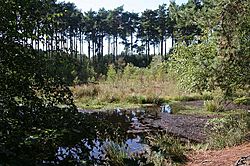Black Lake Nature Reserve facts for kids
Quick facts for kids Black Lake Nature Reserve |
|
|---|---|
 |
|
| Lua error in Module:Location_map at line 420: attempt to index field 'wikibase' (a nil value). | |
| Type | Nature reserve and SSSI |
| Location | Delamere Forest, Cheshire |
| OS grid | SJ537709 |
| Area | 0.4 ha |
| Elevation | 75m |
| Operated by | Cheshire Wildlife Trust |
| Open | any reasonable time |
Black Lake is a special nature reserve found in Delamere Forest, Cheshire, England. It's located in the southwest part of the forest. You can find it just south of the railway line that runs between Manchester and Chester.
This amazing place is looked after by the Cheshire Wildlife Trust (CWT). They work with the Forestry Commission to keep it safe. Black Lake is also a Site of Special Scientific Interest (SSSI). This means it's a very important natural area. Natural England helps make sure it stays protected.
Black Lake is an SSSI because it has a rare type of wetland called a Schwingmoor. This is also known as a "quaking bog." It forms when plants like Sphagnum mosses grow on the water's surface. They create a thick, floating mat of plants. This mat can feel wobbly or "quaky" when you step on it! At Black Lake, this mossy raft covers about half of the lake. The SSSI area, including the land around it, is about 1.74 hectares. The part managed by the Cheshire Wildlife Trust is 0.40 hectares.
This reserve is also famous for its unusual dragonflies. One special type, the white-faced darter, used to live here.
Contents
History of Black Lake
The dip in the ground where Black Lake sits was formed a very long time ago. About 10,000 years ago, at the end of the last Ice Age, a huge block of ice melted here. This created the hollow that eventually filled with water.
In the 1820s, the lake was made bigger to be used as a duck pond. By the 1940s, the entire lake was covered by Sphagnum moss. By 1973, the moss had grown into bumpy mounds. Young trees had also started to grow on these mounds.
Something happened in the past that changed the lake. A road made of crushed limestone was built nearby. This limestone changed how acidic the water was. Because of this, the special Sphagnum cuspidatum moss started to disappear. This moss was important because the young white-faced darter dragonflies lived in it.
In 1995, the limestone material was removed from the area. This helped the floating plant mat to start growing back. However, the white-faced darter dragonfly has not been seen at Black Lake since 1997.
Amazing Animals and Plants
Black Lake is home to many interesting creatures and plants. Here are some of the special ones you might find:
Dragonflies and Damselflies
These beautiful insects are often seen flying around the lake.
- white-faced darter (Leucorrhinia dubia) - last seen in 1997
- brown hawker (Aeshna grandis)
- four-spotted chaser (Libellula quadrimaculata)
- common darter (Sympetrum striolatum)
- black darter (Sympetrum danae)
- large red damselfly (Pyrrhosoma nymphula)
- common blue damselfly (Enallagma cyathigerum)
Unusual Plants
Some plants found here are not common in other parts of the area.
- common sundew (Drosera rotundifolia) - a carnivorous plant that eats insects!
- white sedge (Carex curta)
- common cottongrass (Eriophorum angustifolium) - looks like fluffy cotton
- wild cranberry (Vaccinium oxycoccos)

